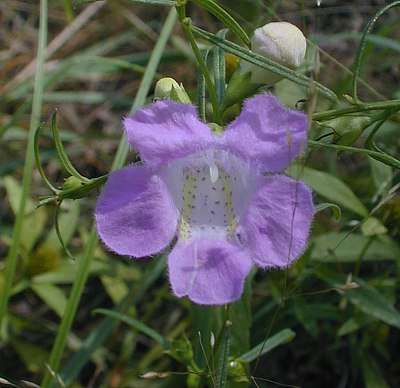Description: This annual plant is 1–2½' tall, branching occasionally. It has a tendency to sprawl in the absence of supportive vegetation. The dark green stems are grooved and hairless. The opposite leaves are 1-3" long, dark green, and linear. They have smooth margins and a prominent midvein. The leaves are usually hairless, although new growth may be slightly pubescent. Secondary leaves may develop from the axils of the primary leaves along the central stem, but they are smaller in size than the latter. Some of the upper stems develop racemes of flowers. These flowers are up to 1" long and across, and vary in color from lavender to purple.

The corolla of each flower is tubular and has 5
spreading lobes that are ciliate, consisting of 2 upper lobes, 2 sides
lobes, and a lower lobe. Within the throat of the corolla there are
specks of dark purple and 2 patches of pale yellow. There are abundant
white hairs within the corolla where the reproductive organs are
located. The anthers are pale yellow and the narrow style is white. The
green calyx is tubular and divided into 5 triangular lobes. These lobes
are one-half the length of the calyx tube or less. The calyx is
hairless and has little or no reticulation. The blooming period occurs
from late summer until the fall, and lasts about a month. There is no
noticeable floral scent. After the flowers are fertilized and wither
away, there develops rounded capsules that are a little longer than the
calyx tube. These capsules contain numerous tiny seeds. When the
capsules split open at the top, gusts of wind can distribution the
seeds a considerable distance. The root system is fibrous and possibly
parasitic on other species of plants. Purple False Foxglove spreads by
reseeding itself, and does not reproduce vegetatively.
Cultivation:
The preference is full or partial sun, and moist soil that is sandy or
peaty. Because the seeds are small, young plantlets may wither away if
they are allowed to become too dry. A soil with an acid pH is preferred.

Range & Habitat:
Purple False Foxglove occurs occasionally throughout Illinois (see Distribution
Map), where it is native. This is one of the more common Agalinis
spp.
in the state. Habitats include moist sand prairies, sandy savannas,
paths and openings in sandy woodlands, boggy areas, and interdunal
sandflats near Lake Michigan. This plant appears to thrive in areas
with occasional disturbance as this removes some of the competing
vegetation.
Faunal Associations:
Bumblebees, digger bees (Melissodes
spp.), and leaf-cutting bees (Megachile spp.)
visit the flowers for nectar and pollen. The caterpillars of the
butterfly Junonia coenia (Buckeye) feed on the
foliage. A flea beetle, Kuschelina
fallax, feeds on a very similar species, Agalinis fasciculata
(Beach False Foxglove), and it is possible that this flea beetle feeds
on other Agalinis spp.,
including Purple False Foxglove. Very little appears to be known about
the relationships of these plants to mammalian herbivores as sources of
food.
Photographic Location:
Along a path in a sandy savanna at Hooper Branch Savanna Nature
Preserve in Iroquois County, Illinois, where this plant species is
locally abundant.
Comments:
The flowers are quite attractive and produced in abundance during the
late summer or fall. At one time the scientific name for this species
was Gerardia purpurea, but the purple-flowered
false foxgloves were reassigned to the genus Agalinis, while the
yellow-flowered false foxgloves were reassigned to the genus
Aureolaria. Distinguishing the different Agalinis spp.
can be tricky as they have similar foliage and flowers. Purple False
Foxglove has larger flowers (up to 1" long and across) than some other Agalinis
spp. and they occur on pedicels (flowering stalks) that are
shorter than the tubular calyx (the pedicels are about 1/8" long). The
flowers are always some shade of purple or lavender, while the flowers
of some Agalinis spp. are often pinkish in
appearance. Purple False Foxglove is quite similar in appearance to Agalinis
fasciculata (Beach False Foxglove), however this latter
species has secondary leaves that are nearly as large as the primary
leaves (i.e., the leaves appear to be whorled along the major stems).
If they are present, such secondary leaves are smaller in size than the
primary leaves in Purple False Foxglove.